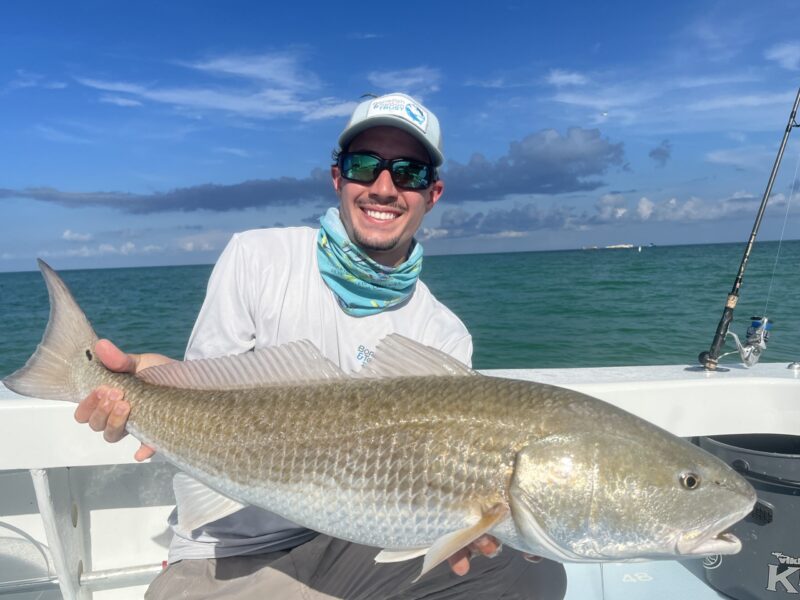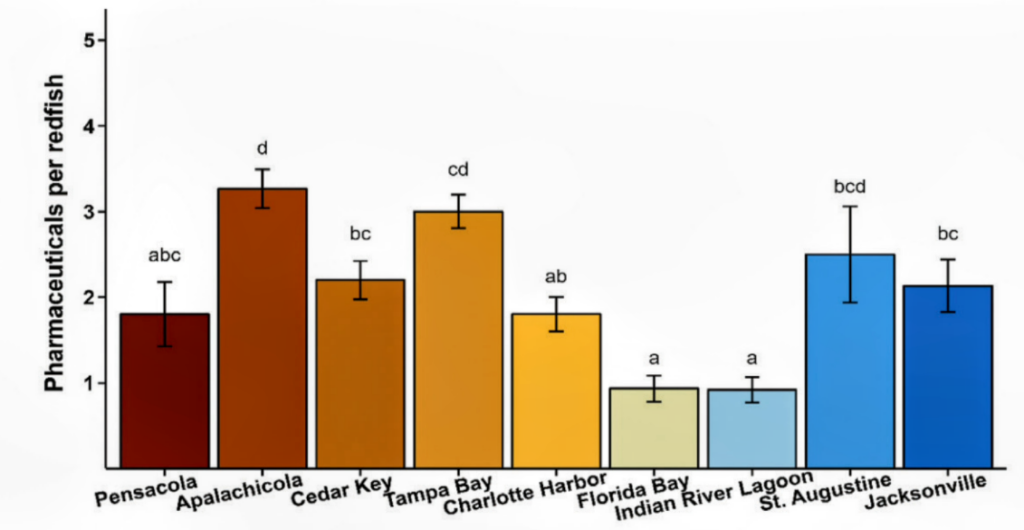One fish, two fish, redfish: Drug fish

A recently released study builds on previous research and leaves no doubt that Florida’s fish have a drug problem.
Local anglers and researchers from Florida International University (FIU) joined throngs of recreational fishers last summer in search of the ever-popular red drum – commonly known as redfish. The goal was to test blood samples for 94 pharmaceutical contaminants.
All 15 fish caught around Tampa Bay tested positive for a heart medication. Only seven of the 113 sampled throughout nine Florida estuaries were clean.
The Miami-based Bonefish and Tarpon Trust (BTT) commissioned the study as part of its extensive research into the issue. Dr. Aaron Adams, director of science and conservation for the BTT, said that if the drugs are in redfish, “they are certainly in every other organism in our coastal waters. So, yeah, that’s a big concern.”
“We have a coastal fish that is exposed to pharmaceuticals that we know will probably cause problems with feeding activity, migratory behavior, survival and reproduction,” Adams elaborated. “In addition, a number of the pharmaceuticals detected, we have absolutely no idea what the effects might be.”

Andy Distrubell takes a blood sample from a redfish caught in Charlotte Harbor. Photo: JoEllen Wilson.
The redfish research follows a 2022 study by the same group that found a plethora of pharmaceutical contaminants in all bonefish sampled from Biscayne Bay and the Florida Keys. Dr. Jennifer Rehage, a fish ecologist from FIU, led both initiatives.
Researchers found 58 various drugs in the bonefish, and each averaged seven. One contained 17 different pharmaceuticals.
While the local redfish sampled did not contain those concentrations, the species is critical to Florida’s $13.9 billion recreational fishery. The latest report stated the findings pose “a significant threat” to an industry that “directly supports more than 120,000 jobs.”
Adams said the redfish study shows the problem extends far beyond Miami and bonefish.
On average, researchers detected 2.1 pharmaceuticals per redfish caught from nine estuaries on the Gulf and Atlantic Coasts. Tampa Bay’s fish averaged three.
That was the second-highest amount across Florida, behind only Apalachicola with 3.3. In addition to heart medication, the most commonly detected drugs were opioid pain relievers and caffeine.
Adams said, “25% of redfish had levels of pharmaceuticals that would be considered therapeutic.” While the concentrations are below “what a limited number of studies on other species” say is harmful to humans eating locally caught fish, scientists remain unaware of long-term exposure effects.
“We just don’t know,” Adams said. “We also don’t know the interactive effects between these pharmaceuticals and other contaminants that people are exposed to.”

A graphic showing the average amount of drugs found in redfish caught throughout nine Florida estuaries. Screengrab.
He hopes the latest study also “rings alarm bells” on all water quality issues. Adams said local and state leaders need to significantly upgrade wastewater treatment systems, a common source of contaminants.
He added that the preponderance of drugs found in fish directly correlates to harmful nutrients that cause red tide and other coastal water problems. He called the state’s wastewater infrastructure outdated for the current population, which continues to grow exponentially.
Some contaminants reach Tampa Bay and other estuaries through groundwater, and Adams explained that poses an additional threat to humans who drink well water.
“We’re already behind,” he said. “So, we have a lot more investment to do to catch up.”
However, there is positive news. Adams said his European colleagues have found they can retrofit outdated wastewater treatment facilities with ozonation systems that remove “the vast majority” of pharmaceuticals and other impurities.
He noted that removing toxins from wastewater before it reaches the ecosystem is much easier than mitigating the aftereffects. Converting septic tanks to sewage infrastructure would also help the problem, but he reiterated that many treatment facilities are already over capacity.
“To a great extent, we’re still behaving as if we were 30, 40 years ago,” he said. “When we have a lot more knowledge on how to be in Florida with considerably less impact.”
Adams expressed his hope that the redfish study raises residents’ awareness and that they support politicians and other local leaders who champion wastewater improvements. Conversely, he would like to see more pressure applied to those who drag their feet on the issue.
He said recent state investments are a step in the right direction, but officials must make long-term commitments to mitigate a problem that has worsened after years of neglect.
“We didn’t get here overnight,” Adams said. “It’s going to take some time to dig out of this.”








John Smith
April 19, 2023at8:13 am
Every toilet flush gets recycled back into the water table. Treatment plants aren’t designed to purify at this chemical level. If they tested for Mercury, PFAS and rocket fuel, you’d look at seafood differently.
John Smith
April 19, 2023at8:08 am
Seriously? No guesses?
Jim reed
April 19, 2023at12:35 am
More needs to be done in preserving Florida.more qualified managers are needed all around. I have had conversations with several code enforcement officers and ?… I asked them simple regulation questions no answers. I knew the answers .
Julie
April 18, 2023at1:30 pm
Maybe big pharma needs to be the ones who do the retro fit of aging infrastructure. They’re the drug pushers. Hold them accountable!
RAYRAY B
April 18, 2023at1:21 pm
The best thing to do is raise awareness and tell people the proper way to dispose of their drugs even pay them to turn them in. Let’s think about that for a minute how much does it cost to clean up the environment or lose a species or lose the ability to eat a species because of contaminants.? It’s a lot cheaper to make the incentive up front and give people a financial incentive to do the right thing. If I were Governor I’d be looking in this area for a lot more than just this problem as it extends into fertilizers and other things!
It’s going to be a lot more costly after the fact then doing a program such as I mentioned up front!
Chris Black
April 18, 2023at10:48 am
The amount of outdated substance’s that are being disposed of improperly by drug companies, pharmacies and such is a huge contributor. Imagine all the CVS, Walgreens, Walmarts, Publix etc when expiration dates come due…Much easier to just dispose of down the back drain…
Dewey Langford
April 18, 2023at6:02 am
They need to get a hold of the fish Doctors tell them that they’re prescribing too much medication to the fish!! They need to put them on pain management system! LMAO I’m just saying
Ken
April 17, 2023at2:08 pm
So….. Eat more Redfish if you have heart problems people…
Carlos
April 17, 2023at12:30 pm
How many fish would you have to eat to feel “high”? Asking for a friend.
Daniel Dillon
April 17, 2023at8:14 am
I’ve been a nurse since 99. Medicare doesn’t take back any drugs. If a patient dies in the nursing home, Medicare says waste the drugs. In the hospital, narcs and other meds are sent down the drain all the time. I used to waste narcs into the house plant at the nurses station, then infection patrol took away the plant. I recently gave up fishing (always fished for food). Now it’s just fish harassment. All supermarket food is poisonous, start eating like it was 1910. Find local farmers that test and support them always. Have money? Send supermarket food to local Lab and test for pfas, narcs, and caffeine. Then send results to local papers. None will publish your work, since none wish to fight local economies based on fishing and food supply. Have a nice day from Maine!
K Kass
April 17, 2023at6:31 am
According to USGS https://www.usgs.gov/special-topics/water-science-school/science/pharmaceuticals-water#overview pharmaceuticals are passed through human waste via sewer treatment facilities. Not only that but outdated or no longer needed Rx are being flushed down the sewer systems. The million dollar question is what percentage of Rx is being flushed? We’ll never know that answer. The alarms and red flags are sounding off to the highest degree. According to this article there’s additional filtering can be retrofitted outdated wastewater treatment facilities with ozonation systems that remove “the vast majority” of pharmaceuticals and other impurities. One way to make change is to contact your state representatives with due diligence to make them aware. Also, make this known to your local officials and pass this on by word of mouth. If we don’t there won’t be any big mouth fish to catch. LOL SERIOUSLY…ACTION IS REQUIRED. This will only be accomplished by voicing our concerns.
Debbie Mendenhall
April 16, 2023at5:07 pm
Google the book OUT STOLEN FUTURES they’ve known about this problem for years Get a copy and read it it’s worse than people know
Eugene Moisan
April 16, 2023at10:47 am
We have to stop building houses and infrastructure that has become a serious problem. The population is over-taxed and cannot handle the quantity of gray water to the environment. Without proper treatment facilities that can handle the toxic bacteria, viruses as well as the dangerous pharmaceuticals this affluent must stop.The greedy companies from NY and Texas are cleaning up on money! from building 10s of thousands of buildings and houses.
These poisons are found in shellfish, fish, and city water.
Wake up people! If you Love Florida stop destroying the land, water and environment, and all the creatures that are native to Florida.
The traffic is crazy, air pollution is causing problems that are not at this time fully aware, but we’re getting closer.
Craig
April 16, 2023at10:40 am
The human body does not use all the medication, vitamins, food that we consume. The rest is sent out in two obvious ways. It’s up to the city, county, or state to treat the water in public systems. They just don’t want to spend the money on the equipment to remove the medications. As long as they meet the federal guidelines, they can just keep doing what they are doing.
Hector F
April 16, 2023at9:35 am
Many people flush their prescriptions down the toilet that’s one way to get it to the waterways.
Perry W McDonald
April 16, 2023at7:58 am
It would be helpful if there was a legend on the chart identifying the letters attributed to the cities.
Maria
April 16, 2023at12:35 am
I have a question where you stated that pharmaceuticals correlate with red tide when we already have scientific evidence that red ride is caused by phosphates contaminating our waters causing algae bloom. Other than that I am aware of no other scientific testing done of other causes- have they done testing regarding pharmaceuticals being a cause? Why are we disposing medications into the water? It sounds like a major problem regarding disposing medications the proper way.
Wayne
April 15, 2023at11:29 pm
On the bright side, if you can’t afford your heart medication, you can eat more redfish.
Shirley Hayes
April 14, 2023at7:19 pm
How are the drugs getting into the water/fish????
Elaine Mosher
April 13, 2023at10:36 am
What people aren’t realizing is if these drugs are prohibiting their production organs then there goes our food supply. This needs to be addressed ASAP.